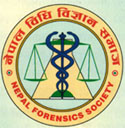NEPAL FORENSIC SOCIETY
Registered under the Nepal Law, Reg.No.622/053-54
|
|
JUSTICE BY FORENSIC SCIENCE
|
Source: Medical Encyclopedia
Forensic Medicine
The
noun forensic medicine has one meaning the branch of medicine that
interprets and establishes the medical facts in civil or criminal law cases.
Also called legal medicine or medical jurisprudence. Medical jurisprudence is a science of applying medical facts to legal problems. Routine tasks include filling out birth and death certificates, deciding insurance eligibility, and reporting infectious disease. Perhaps more significant is medical testimony in court. When merely relating observations, doctors are ordinary witnesses; interpreting facts based on medical knowledge makes them expert witnesses, required to present their opinions without bias toward the side that called them. Conflicts between medicine and law can occur, usually over medical confidentiality. Forensic medicine is one of the largest and most important areas of forensic science. Also called legal medicine or medical jurisprudence, it applies medical knowledge to criminal and civil law. Areas of medicine that are commonly involved in forensic medicine are anatomy, pathology, and psychiatry. Medical jurisprudence or forensic medicine, the application of medical science to legal problems. It is typically involved in cases concerning blood relationship, mental illness, injury, or death resulting from violence. Autopsy (see post-mortem examination) is often used to determine the cause of death, particularly in cases where foul play is suspected. Post-mortem examination can determine not only the immediate agent of death (e.g. gunshot wound, poison), but may also yield important contextual information, such as how long the person has been dead, which can help trace the killing. Forensic medicine has also become increasingly important in cases involving rape. Modern techniques use such specimens as semen, blood, and hair samples of the criminal found in the victim's bodies, which can be compared to the defendant's genetic makeup through a technique known as DNA fingerprinting; this technique may also be used to identify the body of a victim. The establishment of serious mental illness by a licensed psychologist can be used in demonstrating incompetency to stand trial, a technique which may be used in the insanity defense (see insanity), albeit infrequently. The synonym of forensic medicine is forensic pathology. Forensic pathology is the legal branch of pathology concerned with determining cause of death (such as bullet wound to head, exsanguiation, strangulation, etc.) and manner of death (including murder, accident, natural, or suicide). Examination of some wounds and injuries due to crime or negligence Examination of tissue specimens that may be relevant to rape, or other crimes. Forensic pathologists work closely with the coroner (England and Wales) or medical examiner (United States). The examination of dead bodies (autopsy or post mortem) is a subset of anatomical pathology. Often times, a coroner or medical examiner has a background in pathology. Forensic medicine is often used in civil cases. The cause of death or injury is considered in settling insurance claims or medical malpractice suits, and blood tests often contribute to a court's decision in cases attempting to determine the paternity of a child. .
|
|
|

